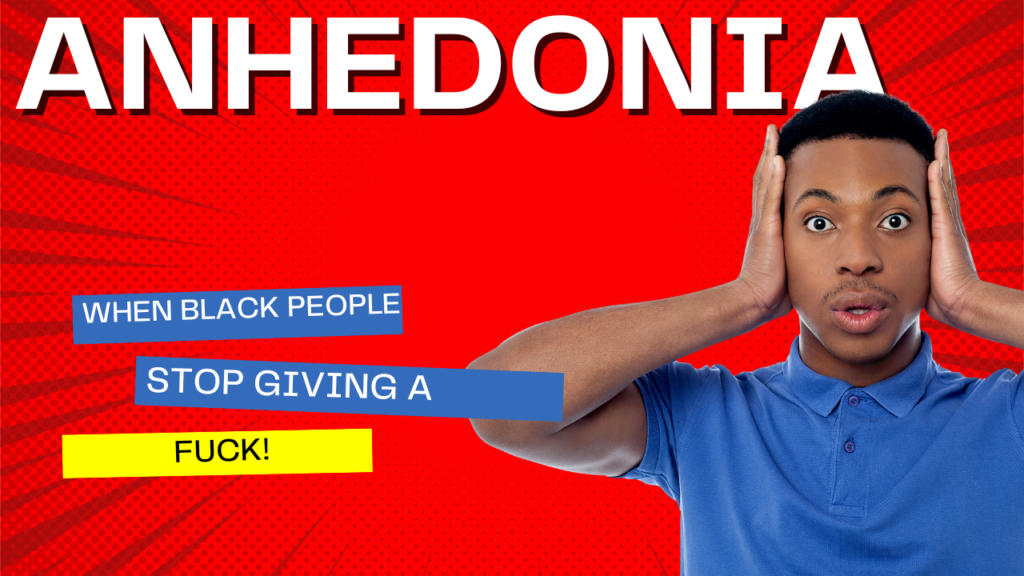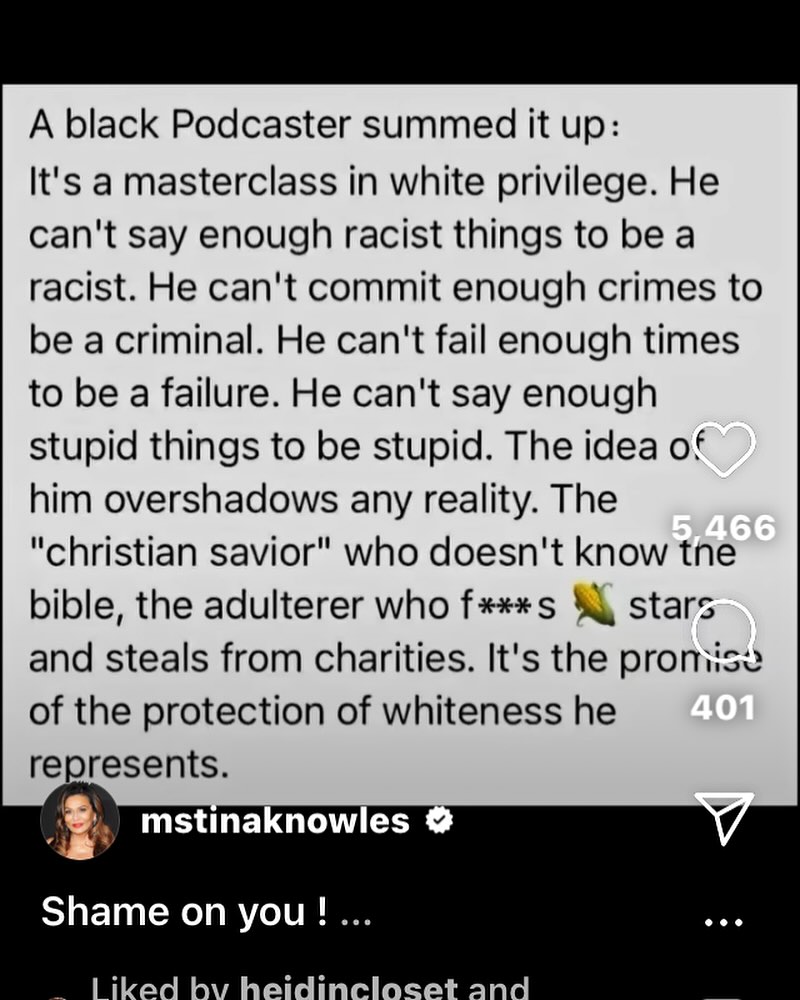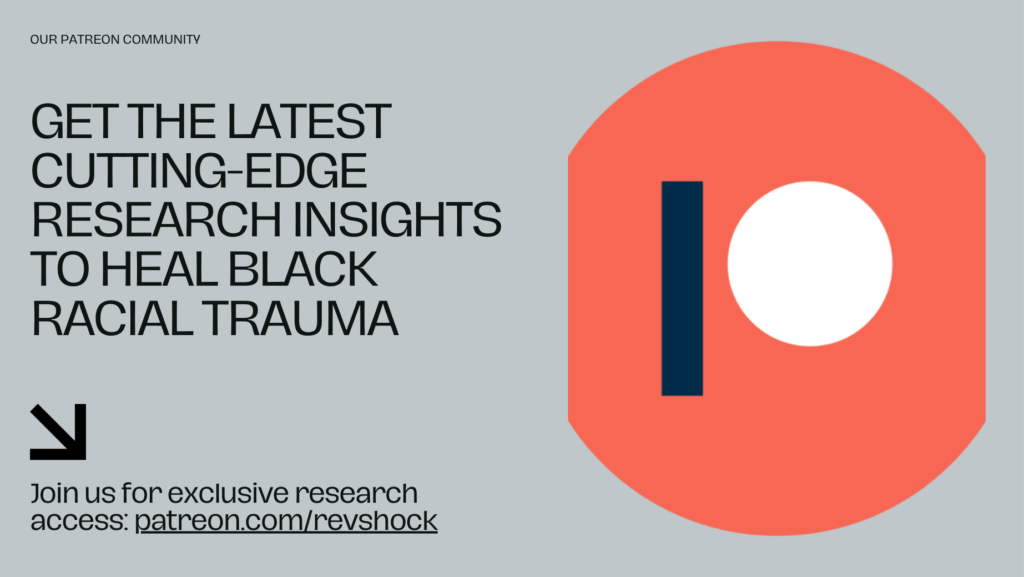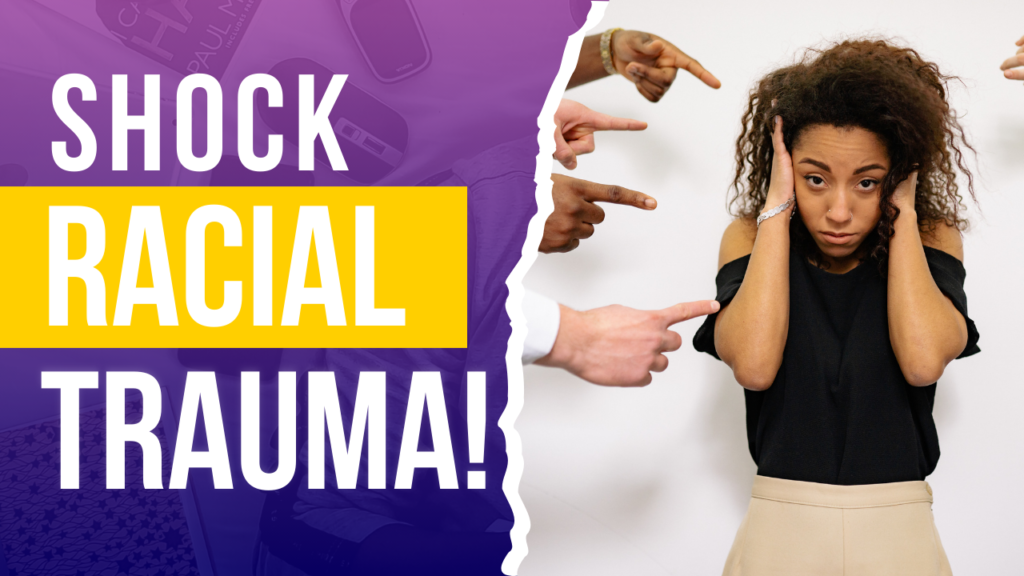
Powered By BlackTraumaGPT.com
Researched and Curated By Rev. Dr. Philippe SHOCK Matthews
(Black Trauma and Mental Health Specialist | Prompt Eng | GPT Dev | Research Scientist | Africana Phenomenologist | Black AI Corsortim co-Founder | Black Mental Health Podcast Host)

After the 2024 election, millions of Black people went into a perpetual state of depression, grief, loss, and pain that imprinted yet another ambiguous trauma onto our nervous system. Many of us, particularly those over the age of 40, have sustained innumerable amounts of racial battle fatigue, which has taken a toll on our bodies and mind, moving us into a numbed state where we just stop giving a fuck. This mental state is known as: Anhedonia.
What Is Anhedonia And How Does It Uniquely Affect Black Peoples
Anhedonia is a psychological condition characterized by an inability to experience pleasure or a diminished interest in activities once found enjoyable. It’s often a symptom of depression, PTSD, and other mental health disorders and can deeply impact a person’s relationships, work, and overall quality of life. For Black communities, anhedonia can manifest in unique ways, influenced by cultural, historical, and social factors related to systemic racism, intergenerational trauma, and ongoing forms of discrimination and oppression.
Cultural and Historical Contexts of Anhedonia in Black Communities
The experience of anhedonia among Black people often intersects with the legacy of the MAAFA (The Black Holocaust), colonialism, and systemic racism. Living under oppressive systems has generational impacts on mental health, including a profound sense of numbness or emotional withdrawal that can resemble or exacerbate anhedonia. Historical trauma, such as the forced loss of family bonds during slavery, the violent policing of Black neighborhoods, and the daily racial microaggressions, compound the risk of experiencing anhedonia as a way to psychologically distance oneself from pain and trauma. Scholars like Dr. Joy DeGruy, through her concept of Post Traumatic Slave Syndrome (PTSS), have highlighted how these generational and racial traumas can result in a numbing of the emotional spectrum, creating vulnerabilities to conditions like anhedonia.
The Role of Racial Battle Fatigue and Everyday Discrimination
For many Black people, the cumulative stress of racial battle fatigue—a term developed by Dr. William A. Smith to describe the psychological and physiological stress responses to enduring daily acts of racial discrimination—can lead to symptoms that align with anhedonia. Constantly navigating environments where they are subjected to racial stereotypes, microaggressions, or outright hostility can produce a kind of emotional exhaustion. Over time, this can erode one’s ability to find joy, as daily discrimination becomes a mental and emotional weight that pushes aside other aspects of life. This can lead to “functional anhedonia,” where joy is masked or obscured as a survival strategy.
The Loss of Joy as Resistance
Anhedonia among Black people can sometimes be a protective mechanism in the face of relentless racial adversity. Resmaa Menakem, in his work on trauma and somatic healing, speaks to how the Black body absorbs and adapts to racial stressors. Anhedonia, in this sense, can be seen as a kind of adaptive response—a way for the mind to shield itself from external harm by muting emotions. Yet, this protective mechanism has consequences, making it difficult to access joy, creativity, and connection, which are essential for resilience and healing.
Anhedonia and Community Engagement
Culturally, Black communities have relied on collective joy, music, spirituality, and social gatherings as vital sources of strength and solidarity. When someone is experiencing anhedonia, they may find it difficult to engage in these communal practices, further alienating them from essential sources of emotional and spiritual renewal. Dr. Thema Bryant emphasizes the healing power of culturally relevant practices like communal support, expressive arts, and storytelling for Black mental health. Anhedonia can interrupt this connection to community and culture, making it hard for those affected to engage fully in spaces that foster resilience.
Addressing Anhedonia with Culturally Affirming Practices
Healing from anhedonia in Black communities may require culturally specific and affirming interventions. Practices rooted in Africana phenomenology and the somatic healing work of practitioners like Dr. Shelly Harrell can help people reconnect with pleasure and presence. Activities like drumming, movement, meditation, and community healing circles can reawaken the body’s connection to joy and pleasure. Additionally, culturally attuned therapy, which respects and incorporates Black cultural values and community contexts, is essential in addressing anhedonia in a way that resonates with lived experiences.
The Path Toward Reclaiming Joy
To support Black individuals affected by anhedonia, it’s crucial to recognize and affirm joy as an act of resistance and a birthright. Programs or spaces that allow for emotional expression, cultural pride, and community validation can be instrumental. Storytelling, artistic expression, and spiritual practices can provide safe, meaningful ways to reconnect with joy, even if only in small doses at first. By understanding anhedonia within the broader context of Black trauma and resilience, we can develop pathways toward healing that honor the full spectrum of Black emotional experience, including the rightful reclamation of joy.
How Are Racial Battle Fatigue And Anhedonia Connected
Racial battle fatigue (RBF) and anhedonia are interconnected in significant ways, especially for Black people who experience the ongoing psychological, emotional, and physical toll of racism and discrimination. While RBF describes the chronic exhaustion and stress response to navigating daily acts of racism, anhedonia reflects a related inability to experience pleasure or joy. Together, these conditions can create a cycle where the exhaustion from racial battle fatigue saps the energy necessary for finding joy, while the inability to feel joy or satisfaction deepens the fatigue and mental health strain.
Here’s how RBF and anhedonia are connected:
1. The Emotional Exhaustion of RBF Leads to Numbness
RBF stems from a constant state of vigilance and hyper-awareness around potential racial harms—microaggressions, hostility, and outright discrimination. This ongoing alertness depletes emotional resources, leading to exhaustion and, over time, a form of emotional numbness. For many, this numbness can look like anhedonia, where even previously enjoyable activities feel dull or unappealing. The chronic stress of RBF exhausts emotional reserves, leaving little space for activities that promote joy and self-fulfillment.
In a survival context, numbing emotions can become a protective mechanism. When one is constantly bracing for racial trauma, disconnecting from feelings can seem safer than engaging with them. Over time, this emotional shutdown, or dissociation, can prevent someone from fully connecting with their own happiness and even their loved ones, creating a disconnect between their internal life and the world around them.
2. Hypervigilance and Reduced Capacity for Joy
RBF requires a level of hypervigilance—a near-constant state of awareness to anticipate potential racial harm. This hypervigilance is mentally and physically draining, and it leaves little mental space for relaxation, spontaneity, or joy. Dr. Bryant’s work on racial trauma suggests that repeated exposure to racism shifts mental focus from thriving to merely surviving. This shift makes it harder to experience pleasure, as the mind becomes preoccupied with self-protection over emotional fulfillment.
Over time, this constant focus on survival can diminish one’s capacity to connect with pleasurable experiences. When the mind is continually occupied with navigating and recovering from racial harm, it cannot fully focus on or enjoy the positive aspects of life. This diminished capacity for joy is a hallmark of anhedonia, which, in this context, is closely linked to the survival mindset necessitated by RBF.
3. Internalized Oppression and Low Self-Worth
For Black individuals, RBF often involves enduring racist stereotypes and microaggressions that chip away at self-esteem and self-worth. These experiences can foster a sense of internalized oppression, where negative stereotypes and biases are internalized and become part of one’s self-perception. This internalization can exacerbate anhedonia, as feelings of low self-worth make it hard to feel deserving of joy or fulfillment.
As Dr. Beverly Daniel Tatum explains, repeated exposure to racism can lead individuals to doubt their own value, even subconsciously. When self-worth is eroded, anhedonia can deepen, as individuals may unconsciously distance themselves from activities that could otherwise bring happiness. In this way, RBF and anhedonia work together to undermine one’s ability to experience joy and satisfaction.
4. Isolation and Withdrawal from Community
RBF often leads to social withdrawal as a way of self-preservation. The exhaustion from navigating predominantly white or hostile environments can push individuals to isolate themselves, feeling that these environments are too draining to engage with regularly. Anhedonia, in turn, exacerbates this withdrawal, as the inability to find joy in social interaction further distances individuals from community and support networks that could otherwise be sources of strength and resilience.
For Black communities, collective joy, spirituality, and togetherness are often vital components of resilience and cultural identity. However, when RBF makes it hard to engage with community life, this withdrawal may lead to further anhedonia, as the person misses out on meaningful social interactions that typically help them recharge. This creates a feedback loop where RBF-induced social withdrawal reinforces anhedonia, and vice versa, making it difficult to reconnect with cultural sources of strength and joy.
5. The Psychological Weight of Suppression
In many situations, Black people experiencing RBF must suppress their true emotions, opinions, or even body language to avoid racial repercussions. This suppression can be exhausting, especially when it is habitual or long-term, leading to a sense of disconnection from one’s authentic self. Anhedonia may then emerge as an emotional response to this disconnection, as it becomes hard to genuinely feel or express emotions when they are routinely suppressed.
The suppression of joy, frustration, or anger in response to racism is a form of emotional labor that contributes to the mental weariness of RBF. This chronic suppression drains emotional vitality, making it hard to feel pleasure even in contexts where it would be natural. Over time, this self-censoring can prevent one from engaging in authentic, joyful experiences, further entrenching anhedonia.
6. Collective and Intergenerational Trauma
Racial battle fatigue can also tap into intergenerational trauma—an inherited emotional and psychological burden passed down through generations as a result of systemic oppression and historical trauma. The concept of Post Traumatic Slave Syndrome (PTSS) explores how historical trauma from slavery, segregation, and systemic racism continues to impact the mental health of Black individuals today. This legacy of trauma can heighten RBF, as individuals not only face current racial stressors but also bear an emotional inheritance from past generations.
The emotional impact of intergenerational trauma can fuel anhedonia, as the heaviness of both personal and ancestral trauma suppresses feelings of joy or pleasure. Healing from anhedonia often requires addressing both current experiences of RBF and the longer history of intergenerational trauma that compounds the experience of joylessness.
Healing Approaches to Break the RBF-Anhedonia Cycle
To address the interconnectedness of RBF and anhedonia, healing strategies must address both the external sources of racial fatigue and the internal emotional impact of joylessness. Some culturally attuned approaches include:
- Restorative and Somatic Practices: Techniques like breathwork, drumming, movement, and grounding exercises, as recommended by Resmaa Menakem, help to release stress stored in the body and reconnect with sensations of pleasure.
- Psychological Sanctuary Spaces: Creating safe, culturally affirming spaces where Black individuals can express themselves freely without fear of racial repercussions can reduce RBF and provide space to reconnect with joy. These spaces can be as formal as affinity groups and therapy sessions, or as informal as gatherings with trusted friends and family.
- Therapeutic Approaches Addressing Racial Trauma: Therapy approaches that validate racial trauma, such as Africana-centered or liberation-based therapy, can help individuals process the impacts of RBF and reconnect with pleasure in a safe, validating environment. Dr. Thema Bryant, for instance, emphasizes integrating culturally relevant practices like storytelling, arts, and spirituality into the healing process.
- Community Joy and Collective Healing: Reclaiming joy in Black communities as an act of resistance against oppression can counteract both RBF and anhedonia. Events centered around Black art, music, spirituality, and cultural pride can serve as spaces of healing, offering collective joy and resilience.
RBF and anhedonia are deeply connected through the exhausting and cumulative effects of racism and discrimination, leading to an erosion of emotional energy, connection, and joy. Healing from both requires addressing the sources of racial trauma while intentionally creating spaces and practices that reconnect Black individuals with sources of joy, community, and self-worth.
The Connection Be Learned Helplessness, Anhedonia And Racial Battle Fatigue
Learned helplessness is a psychological condition that occurs when people feel powerless to change their situation after repeated exposure to negative or uncontrollable experiences. Originally studied by psychologist Martin Seligman, learned helplessness emerges when individuals come to believe that they lack agency or control, leading them to stop attempting to alter or escape their circumstances. For Black people, learned helplessness can be a response to enduring systemic racism, generational trauma, and racial battle fatigue (RBF). When combined with anhedonia, learned helplessness can deepen the sense of emotional numbness and resignation.
Here’s how learned helplessness intersects with anhedonia and racial battle fatigue:
1. The Cycle of Powerlessness and Fatigue
Racial battle fatigue is caused by repeated exposure to racial stressors, including microaggressions, discrimination, and overt hostility. These experiences accumulate over time, making it seem as though no matter how much resilience or strength one shows, the stressors and challenges never fully go away. When facing constant racialized harm without meaningful change or reprieve, a sense of learned helplessness can set in. People may begin to believe that they cannot escape or lessen the impact of racism in their lives, which can lead to a feeling of defeat.
This sense of powerlessness is central to learned helplessness. When individuals feel unable to affect their circumstances, they may begin to disengage mentally and emotionally as a form of self-protection. However, this disengagement can also manifest as anhedonia, where pleasure, hope, and motivation become harder to access. The cycle then reinforces itself: as racial battle fatigue leads to a sense of helplessness, this helplessness feeds into anhedonia, further reducing the energy needed to push against or resist racial stressors.
2. Internalized Powerlessness and Diminished Joy
Over time, learned helplessness can suppress the desire or capacity to engage in activities that might otherwise be pleasurable or fulfilling. The accumulation of racial trauma and constant vigilance required by RBF can lead individuals to avoid activities that feel too challenging or that might expose them to more racialized stress. This avoidance is a key component of learned helplessness; when someone feels they have no power to control their experiences, they may stop trying to engage with the world in ways that previously brought joy or relief.
For example, if a Black individual repeatedly encounters racial hostility in professional or social settings, they may begin to avoid these settings, expecting that their efforts to connect or succeed will be met with resistance or harm. This withdrawal can deepen anhedonia, as withdrawing from the social sphere cuts off opportunities for joy, support, and validation. Dr. Beverly Daniel Tatum’s concept of “the cumulative racial trauma effect” explains that such experiences can undermine self-worth, and when this is internalized, it becomes difficult to believe that one is deserving or capable of joy, further reinforcing the cycle of learned helplessness.
3. Reduced Motivation to Resist or Heal
Learned helplessness diminishes motivation, making it harder for individuals to seek out or engage in healing practices. For Black individuals experiencing RBF, this lack of motivation might mean less engagement with supportive communities or culturally affirming spaces that could help restore energy and reduce the emotional toll of RBF. Without the motivation to resist or seek out coping mechanisms, individuals can feel trapped within a cycle of helplessness and anhedonia, where even the thought of accessing joy or fulfillment feels futile.
In the face of systemic racism, learned helplessness can create a sense of inevitability around racial suffering. This fatalism—believing that systemic change or personal relief is impossible—can strip individuals of the motivation to seek or advocate for change. The inability to imagine a different or more just reality is central to anhedonia in this context, where the belief that “nothing will change” translates into a deeper sense of joylessness and despair.
4. Impact on Collective and Intergenerational Resilience
Learned helplessness can erode collective resilience by diminishing people’s trust in community-led change or activism. In the context of Black history, collective resilience and resistance have always been central to combating racial oppression. However, when individuals are worn down by RBF and anhedonia, learned helplessness can interfere with the ability to believe in collective healing or the possibility of change. This impact is also intergenerational, as younger generations may inherit a sense of despair or fatalism from witnessing older generations struggle with similar battles against racism.
This intergenerational learned helplessness has roots in historical traumas, such as the MAAFA, Jim Crow segregation, and the violent policing of Black communities. The historical trauma of slavery and racial violence has created survival strategies that, while protective in certain historical contexts, can also hinder personal and collective joy today. Learned helplessness, as an inherited response, can therefore deepen anhedonia within families and communities, as generations struggle to see possibilities beyond the trauma they have collectively endured.
5. Self-Blame and Internalized Oppression
Learned helplessness often leads to self-blame, as individuals may internalize the belief that their inability to overcome or escape racial stressors is a personal failing. This internalized oppression compounds RBF, as the sense of helplessness shifts from the external (society’s systemic racism) to the internal (personal inadequacy). Self-blame is deeply linked to anhedonia because it creates a mental block against self-compassion, self-worth, and the idea of deserving joy. When people are conditioned to believe they are responsible for their circumstances, it becomes even harder to break free from anhedonia and embrace self-affirming practices.
For example, Black students in predominantly white institutions who face racial microaggressions and isolation might begin to believe that they are “not good enough” or that their struggles are a result of personal shortcomings, rather than systemic racism. This self-blame fosters learned helplessness, as they may internalize the idea that their efforts are ineffective, no matter how hard they try. The weight of this internalized oppression can lead to further disengagement, making it difficult to feel motivated to participate in academic or social activities, which can contribute to a deepening sense of anhedonia.
6. Disconnection from Community and Cultural Joy
Learned helplessness can also contribute to disconnection from one’s community, culture, and sources of collective joy. Black culture, historically and presently, offers profound resources of resilience, joy, and solidarity. From music and spirituality to shared gatherings and communal practices, these aspects of culture serve as powerful tools to combat racial trauma and racial battle fatigue. However, learned helplessness can dull the desire or willingness to seek out these sources of joy, as it fosters a sense of detachment and resignation.
When people begin to feel that they cannot control or change their circumstances, they may withdraw from these joyful, collective practices, losing out on the healing benefits they offer. For instance, someone who feels helpless in the face of racial stress might avoid community events, assuming that nothing will alleviate their suffering. This withdrawal from community further isolates individuals and deprives them of a valuable source of resilience, intensifying both RBF and anhedonia.
7. Breaking the Cycle: Pathways to Healing and Empowerment
To address the interconnected cycle of racial battle fatigue, learned helplessness, and anhedonia, healing efforts must focus on restoring a sense of agency, community, and connection to joy. Some strategies include:
- Empowerment through Culturally Relevant Therapy: Therapy that addresses racial trauma directly, such as Africana-centered or liberation-based therapies, can help individuals recognize how external racial oppression, rather than personal failure, contributes to feelings of helplessness. By re-establishing a sense of agency, therapists can help clients break out of the cycle of learned helplessness. Additionally, such therapy can provide tools for reclaiming joy, fostering self-worth, and reducing anhedonia.
- Community Healing and Psychological Sanctuary: Spaces that offer psychological sanctuary, where Black individuals can safely express themselves without the pressures of racial judgment, are essential. In these spaces, community members can share experiences, support one another, and validate their struggles and resilience. Community healing gatherings, expressive arts, and spiritual practices rooted in Black culture allow individuals to reconnect with joy and experience collective empowerment, reducing the effects of learned helplessness.
- Resilience-Building and Somatic Practices: Techniques like meditation, yoga, grounding exercises, and trauma-informed movement practices help to release the physical manifestations of racial trauma. Resmaa Menakem’s somatic work, for example, teaches people to reconnect with their bodies as sources of strength and power. By working through bodily stress, individuals can reduce the lingering effects of RBF and the physical components of learned helplessness, making it easier to experience joy and satisfaction.
- Reclaiming Cultural Joy as Resistance: Recognizing joy as an act of resistance against oppression can help dismantle the helplessness that racism often instills. Black joy is powerful; reclaiming cultural expressions of happiness, pride, and creativity provides an important counter to feelings of learned helplessness. Black-led art, music, storytelling, and celebrations can empower individuals and communities by affirming cultural pride and resilience, helping to restore motivation and foster emotional fulfillment.
- Education and Advocacy for Systemic Change: Beyond individual and community healing, addressing the broader sources of racial battle fatigue and learned helplessness requires systemic change. Advocacy efforts focused on creating equitable workplaces, fairer educational systems, and anti-racist policies reduce the sources of racial trauma and create environments where Black people can thrive. When people see that efforts for racial justice and equality are leading to actual change, their sense of agency and hope can be restored, which in turn reduces feelings of helplessness.
Reclaiming Agency and Joy in the Face of Racial Trauma
Ultimately, the interconnectedness of RBF, learned helplessness, and anhedonia reveals how deep and pervasive the effects of racial trauma can be. Yet, understanding these links also opens up pathways to healing. By breaking the cycle of helplessness, reconnecting with community and cultural sources of joy, and advocating for systemic change, Black individuals and communities can begin to counteract the forces that diminish joy and agency. The journey toward healing requires both individual resilience and collective action, as well as a renewed commitment to reclaiming the spaces of joy, pride, and fulfillment that are essential to well-being.
Through these efforts, Black individuals can work to not only survive but also find spaces to thrive, where joy, fulfillment, and self-determination become central parts of their lives despite the persistent challenges of systemic racism.
If nothing is wrong with you and something happened to you…are you ready to find out what to do about it? Shock Trauma Spiritual Counseling Discovery Call https://t.ly/VJWqJ | BlackTraumaGPT.com: Beginner’s User Guide https://t.ly/HtHMX | Programming chatGPT for Black Self Mental Health, Trauma, and Healing https://amzn.to/47P8MXK
Enjoying Our Content?
Become a member of our Patreon to get the latest research on Racial Black Trauma https://www.patreon.com/revshock. Or buy Rev. SHOCK a Coffee! https://bit.ly/3yg5D7A


Book A Discovery Call
Are you ready to SHOCKtrauma? Click HERE now to book a discovery call with Rev. Dr. Philippe SHOCK Matthews

Get Social with Doc SHOCK:
PATREON: https://t.ly/mjksf | REV. DR. SHOCK (PERPLEXITY PAGE): https://t.ly/ppjwh | SOLO: https://solo.to/revshock | BIO: https://t.ly/Ko_y_ | BLOG: https://t.ly/j6bh0 | PODCAST: https://t.ly/cB5GD | ENDORSEMENT: https://t.ly/jFErO | THREADS: https://t.ly/SoKkT | IG: https://t.ly/XsN8f | FB: https://t.ly/R3r9Y | X: https://t.ly/iJ-wy | LINKEDIN: https://t.ly/GZ0pe | TIKTOK: https://t.ly/zfp60 | BLACK TRAUMA GPT: https://t.ly/vswbs | BLACK AI CONSORTIUM: https://t.ly/uiRZN | BOOKS BY PM: https://t.ly/vvHMd
